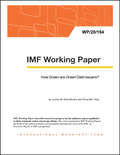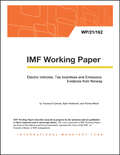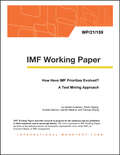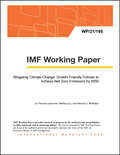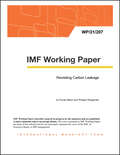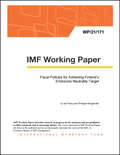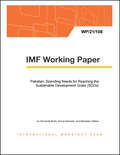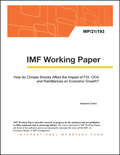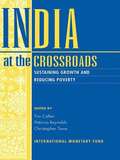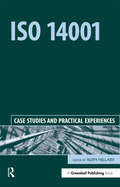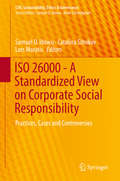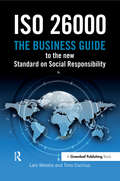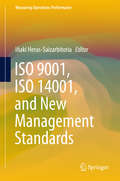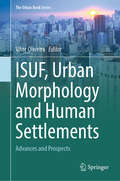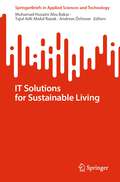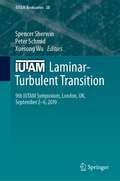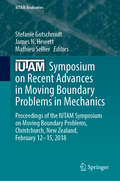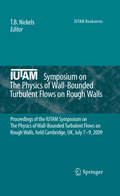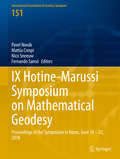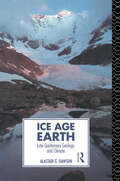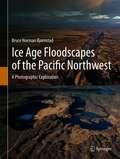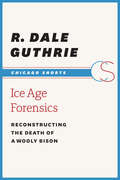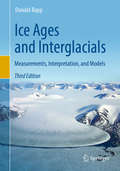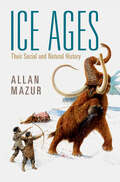- Table View
- List View
IMF: Recent Economic Developments (Imf Working Papers #Imf Staff No. 97/107)
by International Monetary FundA report from the International Monetary Fund.
IMF: Recent Economic Developments (Imf Working Papers #Imf Staff No. 97/107)
by International Monetary FundA report from the International Monetary Fund.
IMF: Recent Economic Developments (Imf Working Papers #Imf Staff No. 97/107)
by International Monetary FundA report from the International Monetary Fund.
IMF: Recent Economic Developments (Imf Working Papers #Imf Staff No. 97/107)
by International Monetary FundA report from the International Monetary Fund.
IMF: Recent Economic Developments (Imf Working Papers #Imf Staff No. 97/107)
by International Monetary FundA report from the International Monetary Fund.
IMF: Recent Economic Developments (Imf Working Papers #Imf Staff No. 97/107)
by International Monetary FundA report from the International Monetary Fund.
IMF: Recent Economic Developments (Imf Working Papers #Imf Staff No. 97/107)
by International Monetary FundA report from the International Monetary Fund.
IMF: Recent Economic Developments (Imf Working Papers #Imf Staff No. 97/107)
by International Monetary FundA report from the International Monetary Fund.
IMPROVED SEISMIC MONITORING IMPROVED DECISION-MAKING: Assessing the Value of Reduced Uncertainty
by National Research Council of the National AcademiesImproved Seismic Monitoring—Improved Decision-Making, describes and assesses the varied economic benefits potentially derived from modernizing and expanding seismic monitoring activities in the United States. These benefits include more effective loss avoidance regulations and strategies, improved understanding of earthquake processes, better engineering design, more effective hazard mitigation strategies, and improved emergency response and recovery. The economic principles that must be applied to determine potential benefits are reviewed and the report concludes that although there is insufficient information available at present to fully quantify all the potential benefits, the annual dollar costs for improved seismic monitoring are in the tens of millions and the potential annual dollar benefits are in the hundreds of millions.
INDIA at the Crossroads
by Christopher Towe Tim Callen Patricia ReynoldsMacroeconomic developments during 2000 including a rebound of inflation, slowing industrial production, and downward pressure on the rupee and stock prices and have tempered optimism for India's macroeconomic performance during the last decade. They also underscore the longer-standing question of whether the basis for achieving sustained and rapid growth has yet been established in India. Most notably, fiscal policy, structural policy and poverty. These issues have been at the core of the ongoing policy dialog between the IMF staff and the Indian authorities, and this volume brings together some of the IMF staff's more recent analysis of these topics. Four main issues are addressed. Part I explores the factors underlying India's success in avoiding significant fallout from the Asia crisis and addresses broader questions regarding India's external vulnerability. Part II discusses the fiscal situation and the extent to which recent policies pose risks to India's growth prospects and debt sustainability. Monetary policy and financial sector reform are considered in Part III, and structural issues, including those related to poverty and interstate growth and structural policy implementation are covered in Part IV.
ISO 14001: Case Studies and Practical Experiences
by Ruth HillaryISO 14001 is the star standard among the International Organization for Standardization's ISO 14000 series of environmental management standards. It has seen spectacular growth since its launch in September 1996. Worldwide registrations are set to pass the 20,000 mark in 2000 with 20 times that number reportedly waiting in the wings.In 30 explicit but concise chapters, ISO 14001: Case Studies and Practical Experiences seeks to unravel the truth behind what can and cannot be achieved by ISO 14001 and aims to provide readers with enough knowledge to make choices about its relevance and importance not only to their worlds but also to society. Written by leading practitioners, certifiers, consultants, government and academics, the book examines both the real benefits and the shortcomings organizations have experienced with ISO 14001. We learn from both.Far more ambitious than an implementation guide, the book will provide those readers struggling with the standard first-hand experiences of the real issues they will face in implementing their EMS and, just as importantly, what certifiers look for when they visit firms. ISO 14001: Case Studies and Practical Experiences is a warts-and-all expose of ISO 14001: the issues tackled; the problems faced and overcome; and, above all, the astonishing flexibility of its uses and the diversity of its users.This important book is a must for businesses, researchers, consultants, government officials, students, NGOs and support organisations who want more than just another how-to-do-it manual; but rather the truth about how ISO 14001 is really working on the ground.
ISO 26000 - A Standardized View on Corporate Social Responsibility: Practices, Cases and Controversies (CSR, Sustainability, Ethics & Governance)
by Samuel O. Idowu Catalina Sitnikov Lars MoratisThis book provides a comprehensive and detailed introduction to the ISO 26000 standard for social responsibility (SR) in businesses and corporations. In addition to discussing the standard’s focus on various stakeholders and seven core topics, the book underscores its key aspects and most debatable issues, with a focus on its connection to sustainable business practices. It presents numerous cases and practical examples of the ISO 26000’s implementation and discusses the outcomes and lessons learned, in terms of the extent to which organizations can envision practicing CSR in ways that fit their activities, stakeholders and environment. Lately, the ISO 26000 has proved to offer an interesting and important approach to the standardization of (corporate) social responsibility. Approached and perceived as a voluntary standard that does not include any specific requirements, determining the best way to implement and work with it involved a considerable amount of experimentation. This book showcases the current state of application and discusses how different countries have developed their own specific versions of the standard, which organizations can use to certify their SR processes.
ISO 26000: The Business Guide to the New Standard on Social Responsibility (Csr, Sustainability, Ethics And Governance Ser.)
by Lars Moratis Timo CochiusOver the last ten years, Corporate Social Responsibility (CSR) has grown from being criticised as a management fad to being endorsed as good business practice by the majority of the world's leading companies. It has also become ever more complex; and the majority of companies are now in need of clarity and guidance to actively engage with CSR in practice, to develop strategies that reflect the unique context in which each company operates and to embed CSR within their values. ISO, the International Organization for Standardization, began developing an International Standard providing guidelines for social responsibility (SR) in 2005. This long-awaited guidance standard was finally published in November, 2010 as ISO 26000. Developed by stakeholders from industry, government, labour, consumers, non-governmental organizations and others, ISO 26000 will almost certainly become the single most authoritative worldwide standard for SR. In only a few years' time, many thousands of organizations around the world are likely to be using ISO 26000 as a foundation for their SR policies. ISO 26000 is voluntary, and includes no specific requirements; therefore it is not a certification standard. Nonetheless, business users in particular are anxious to measure against the new ISO guideline their current efforts at implementing SR issues within their overall business strategy. Furthermore, many organizations have indicated that they may reformulate current strategies or develop new initiatives based on the content of ISO 26000. This book, written by international experts who have closely followed the development of ISO 26000, is the first to provide potential users with a comprehensive roadmap to the new standard and a compass to identify where they stand in relation to it now. ISO 26000 defines all of the key terminology of SR, provides advice about the ways in which organizations can identify their social responsibilities and how SR can be integrated not only into companies, but into all types of organizations. It is not another code or norm, but an overarching blueprint for social responsibility. This book covers all the key content of ISO 26000, examining the development of the standard, the topics covered and how key themes such as stakeholders are dealt with. It is rich in tools and benchmarking exercises, illustrative material, case examples, and help for companies looking to base their CSR policy on ISO 26000. It also contains an overview of the actions and expectations of organizations that wish to work in accordance with ISO 26000. Timely, detailed and practical, ISO 26000: The Business Guide to the New Standard on Social Responsibility will be an essential resource for the thousands of organizations that need an expert view on how the new standard works, where they stand in relation to it, and how they can work towards developing their CSR efforts in line with its content.
ISO 9001, ISO 14001, and New Management Standards (Measuring Operations Performance)
by Iñaki Heras-SaizarbitoriaThis book is a comprehensive reference on ISO management system standards and their implementation. The impacts that ISO 9001 and ISO 14001 have had on business performance are analyzed in depth, and up-to-date perspectives are offered on the integration of these and other management standards (e.g. SA8000, ISO/TS 16949). Detailed information is provided on the signaling value of different management standards and on the new ISO standards for management systems, such as ISO 50001 and ISO 45001, relating to energy management and occupational health and safety. The role of audits in ensuring compliance with the standards and achievement of objectives is also carefully considered. The volume examines avenues for further research and emerging challenges. In offering an integrated, holistic perspective on ISO management system standards, this book will have wide appeal for academics, public decision-makers, and practitioners in the field of quality and environmental management.
ISUF, Urban Morphology and Human Settlements: Advances and Prospects (The Urban Book Series)
by Vítor OliveiraThis book offers insight into the most important scientific society on urban morphology worldwide: the International Seminar on Urban Form (ISUF). After addressing the three-decade history of ISUF, the book analyses the present and future of this scientific society, of urban morphology, and of human settlements. This timely and fundamental reflection gathers contributions from present and past leadership of ISUF since its inception in 1994. Over the last three decades, the urban world has undergone major changes: the urban population is now higher than the rural population; more than half of the world's population lives on a single continent—Asia, home to almost three billion people in China and India alone—so geographical imbalance is considerable; and while half of the urban population still lives in small cities of fewer than 300,000 inhabitants, the number of megacities has increased significantly. How does the physical form of cities in different parts of the world respond to these dynamics? Can cities preserve fundamental elements of humankind's urban heritage while accommodating changes driven by the main socioeconomic and environmental needs of today? The field of urban morphology has been continuously adjusting to the essential dynamics of its object of study. While developing and strengthening its most robust theories, concepts, and methods designed after the mid-twentieth century, urban morphology has been able to integrate innovative approaches for describing and explaining the emerging dynamics and patterns of urban form—often incorporating groundbreaking technologies for data collection, analysis, modelling, and simulation. But what is the role of urban morphology in science and society today? How effective is it in communicating a rigorous understanding of the urban landscape both to academics and researchers in other fields and to citizens in general? How successful is it in providing practitioners with relevant and useful knowledge that informs their action on cities' form and structure through spatial planning, urban design, and architecture? This book addresses these fundamental questions, offering academics, researchers, and practitioners comprehensive knowledge on human settlements, the field of urban morphology, and the role of ISUF in promoting groundbreaking morphological thought.
IT Solutions for Sustainable Living (SpringerBriefs in Applied Sciences and Technology)
by Andreas Öchsner Muhamad Husaini Abu Bakar Tajul Adli Abdul RazakIn today's dynamic and competitive business environment, industries face numerous challenges related to process optimization, energy consumption, and technological advancements. Efficient management of industrial processes is crucial for maximizing productivity, reducing waste, and ensuring sustainable growth. Similarly, energy consumption and maintenance play a pivotal role in achieving cost-effectiveness and environmental sustainability. Moreover, advancements in technology and engineering have the potential to revolutionize industrial operations and enhance overall performance. This research book provides an analysis of various topics encompassing industrial processes, energy consumption, and technology in engineering management. The book encompasses three main categories. The first category is related to industrial processes, which investigate methodologies and techniques to identify and eliminate waste. The second category is discussing energy consumption and maintenance strategies in industrial and building environments. This section aims to optimize energy usage, reduce costs, and promote sustainable practices. Lastly, the third category in technology and engineering explores advancements in technology and engineering and their applications in industrial settings. This section investigates innovative solutions and techniques to enhance productivity, optimize processes, and improve overall performance. The research book aims to become a valuable resource for researchers, practitioners, and policymakers interested in smart technologies and sustainable living.
IUTAM Laminar-Turbulent Transition: 9th IUTAM Symposium, London, UK, September 2–6, 2019 (IUTAM Bookseries #38)
by Peter Schmid Spencer Sherwin Xuesong WuThis volume comprises the carefully revised papers of the 9th IUTAM Symposium on Laminar-Turbulent Transition, held at the Imperial College, London, UK, in September 2019. The papers focus on the leading research in understanding transition to turbulence, which is a challenging topic of fluid mechanics and arises in many modern technologies as well as in nature. The proceedings are of interest for researchers in fluid mechanics and industry who have to handle these types of problems, such as in the aeronautical sector.
IUTAM Symposium on Recent Advances in Moving Boundary Problems in Mechanics: Proceedings of the IUTAM Symposium on Moving Boundary Problems, Christchurch, New Zealand, February 12-15, 2018 (IUTAM Bookseries #34)
by Stefanie Gutschmidt James N. Hewett Mathieu SellierMany problems in mechanics involve deformable domains with moving boundaries, including fluid-structure interaction, multiphase flows, flows over soft tissues and textiles, or flows involving accretion/erosion to name but a few. The presence of a moving boundary presents considerable challenges when it comes to modelling and understanding the underlying system dynamics. This proceedings volume collects contributions made at the IUTAM Symposium on Recent Advances in Moving Boundary Problems in Mechanics held in Christchurch, New Zealand in February 2018.
IUTAM Symposium on The Physics of Wall-Bounded Turbulent Flows on Rough Walls
by T. B. NickelsThis work describes the state-of-the-art in the understanding of turbulent wall-bounded flows developing on rough surfaces. This symposium brought together the best researchers in the field to discuss the technical issues and develop a consistent approach to the subject - hence it is an up-to-date reference work for research in this area.
IX Hotine-Marussi Symposium on Mathematical Geodesy: Proceedings of the Symposium in Rome, June 18 – 22, 2018 (International Association of Geodesy Symposia #151)
by Fernando Sansò Nico Sneeuw Mattia Crespi Pavel NovákThis volume gathers the proceedings of the IX Hotine-Marussi Symposium on Mathematical Geodesy, which was held from 18 to 22 June 2018 at the Faculty of Civil and Industrial Engineering, Sapienza University of Rome, Italy. Since 2006, the Hotine-Marussi Symposia series has been produced under the auspices of the Inter-Commission Committee on Theory (ICCT) within the International Association of Geodesy (IAG). The ICCT has organized the last four Hotine-Marussi Symposia, held in Wuhan (2006) and Rome (2009, 2013 and 2018). The overall goal of the ICCT and Hotine-Marussi Symposia has always been to advance geodetic theory, as reflected in the 25 peer-reviewed research articles presented here.The IX Hotine-Marussi Symposium was divided into 10 topical sessions covering all aspects of geodetic theory including reference frames, gravity field modelling, adjustment theory, atmosphere, time series analysis and advanced numerical methods. In total 118 participants attended the Symposium and delivered 82 oral and 37 poster presentations. During a special session at the Accademia Nazionale deiLincei, the oldest scientific academy in the world, six invited speakers discussed interactions of geodesy with oceanography, glaciology, atmospheric research, mathematics, Earth science and seismology.
Ice Age Earth: Late Quaternary Geology and Climate (Physical Environment Ser.)
by Alastair G. DawsonIce Age Earth provides the first detailed review of global environmental change in the Late Quaternary. Significant geological and climatic events are analysed within a review of glacial and periglacial history. The melting history of the last ice sheets reveals that complex, dynamic and catastrophic change occurred, change which affected the circulation of the atmosphere and oceans and the stability of the Earth's crust.
Ice Age Floodscapes of the Pacific Northwest: A Photographic Exploration
by Bruce Norman BjornstadThis heavily illustrated book contains descriptions and geologic interpretations of photographs (mostly aerial) illustrating the power and magnitude of repeated Ice Age flooding in the Pacific Northwest, as recently as 14,000 years ago. The scale of Ice Age floods was so huge that today it is often difficult to see and appreciate the power and magnitude of such megafloods from ground level. However, from the air, landforms created by the floods often come into clear focus. Aerial images, obtained via unmanned aerial vehicle (drone) as well as fixed-wing airplane, add a new perspective on evidence gathered by dozens of scientists since 1923.
Ice Age Forensics: Reconstructing the Death of a Wooly Bison
by R. Dale GuthrieFrozen mammals of the Ice Age, preserved for millennia in the tundra, have been a source of fascination and mystery since their first discovery over two centuries ago. The 1979 find of a frozen, extinct steppe bison in an Alaskan gold mine allowed paleontologist Dale Guthrie to undertake the first scientific excavation of an Ice Age mummy in North America and to test theories about these enigmatic frozen fauna. In this brilliant remaking of the death of a wooly bison over 36,000 years ago, we're given a glimpse of what life was like during the Pleistocene Epoch. From torn fragments and patches of deep-frozen skin and insights gleaned from studies of Montana bison, African lions, and Iberian cave art, Ice Age Forensics presents the story of the huge carcass Guthrie calls "Blue Babe"--and the excitement surrounding its reconstruction.
Ice Ages and Interglacials: Measurements, Interpretation, and Models (Springer Praxis Books. Environmental Sciences Ser.)
by Donald RappThis book provides a detailed review of terminations of ice ages, including a very attractive theory based on dust deposits on ice sheets. While other books on ice ages are mostly short, popular, and non-technical, the only book that attempts to deal with the broad issues of what we know about past ice ages and why they occur is the book by Muller and MacDonald (M&M), published by Praxis. However, despite its many good features, this book suffers from an inordinate emphasis on spectral analysis, a lack of coverage of new data, and a very confusing sequence of chapters. As a result, the data and theory are so intimately entwined that it is difficult to separate one from the other. This volume provides an independent and comprehensive summary of the latest data, theories and analysis. This third edition of what has become the premier reference and sourcebook on ice ages addresses recent topics, and includes new references, new data, and a totally new, greatly expanded treatment of terminations of ice ages.
Ice Ages: Their Social and Natural History
by Allan MazurWhat causes Ice Ages? How did we learn about them? What were their affects on the social history of humanity? Allan Mazur's book tells the appealing history of the scientific 'discovery' of Ice Ages. How we learned that much of the Earth was repeatedly covered by huge ice sheets, why that occurred, and how the waning of the last Ice Age paved the way for agrarian civilization and, ultimately, our present social structures. The book discusses implications for the current 'controversies' over anthropogenic climate change, public understanding of science, and (lack of) 'trust in experts'. In parallel to the history and science of Ice Ages, sociologist Mazur highlights why this is especially relevant right now for humanity. Ice Ages: Their Social and Natural History is an engrossing combination of natural science and social history: glaciology and sociology writ large.
